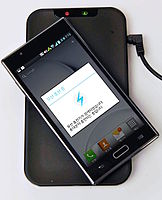
Photo from wikipedia
Traditional Potentiometric Ion-selective Electrodes (ISE) are widely used in industrial and clinical settings. The simplicity and small footprint of ISE have encouraged their recent adoption as wearable/implantable sensors for personalized… Click to show full abstract
Traditional Potentiometric Ion-selective Electrodes (ISE) are widely used in industrial and clinical settings. The simplicity and small footprint of ISE have encouraged their recent adoption as wearable/implantable sensors for personalized healthcare and precision agriculture, creating a new set of unique challenges absent in traditional ISE. In this paper, we develop a fundamental physics-based model to describe both steady-state and transient responses of ISE relevant for wearable/implantable sensors. The model is encapsulated in a “generalized Nernst formula” that explicitly accounts for the analyte density, time-dynamics of signal transduction, ion-selective membrane thickness, and other sensor parameters. The formula is validated numerically by self-consistent modeling of multispecies ion-transport and experimentally by interpreting the time dynamics and thickness dependence of thin-film solid-contact and graphene-based ISE sensors for measuring soil nitrate concentration. These fundamental results will support the accelerated development of ISE for wearable/implantable applications.
Journal Title: IEEE Transactions on Biomedical Engineering
Year Published: 2022
Link to full text (if available)
Share on Social Media: Sign Up to like & get
recommendations!